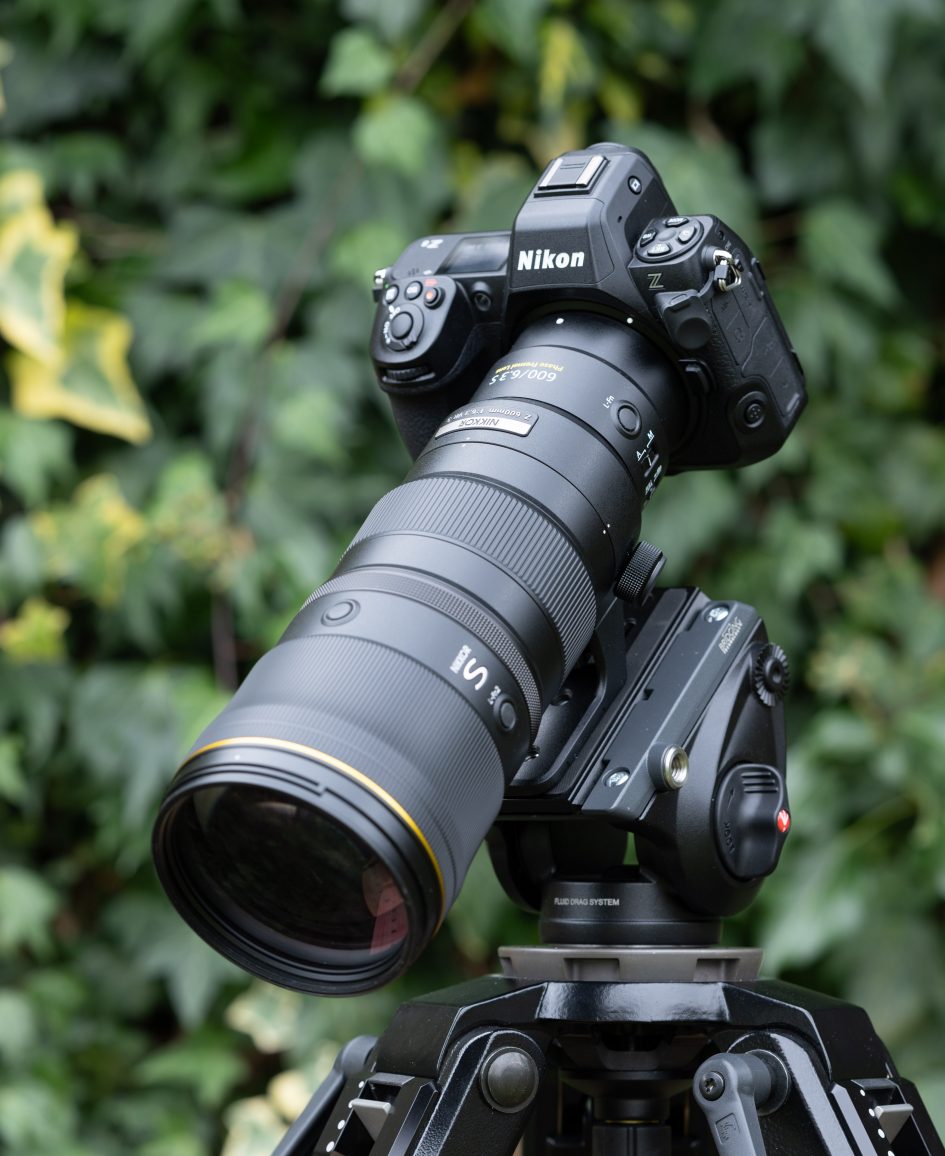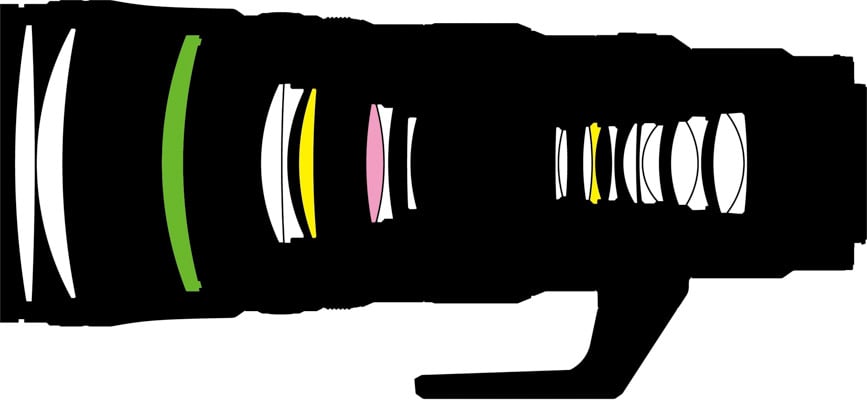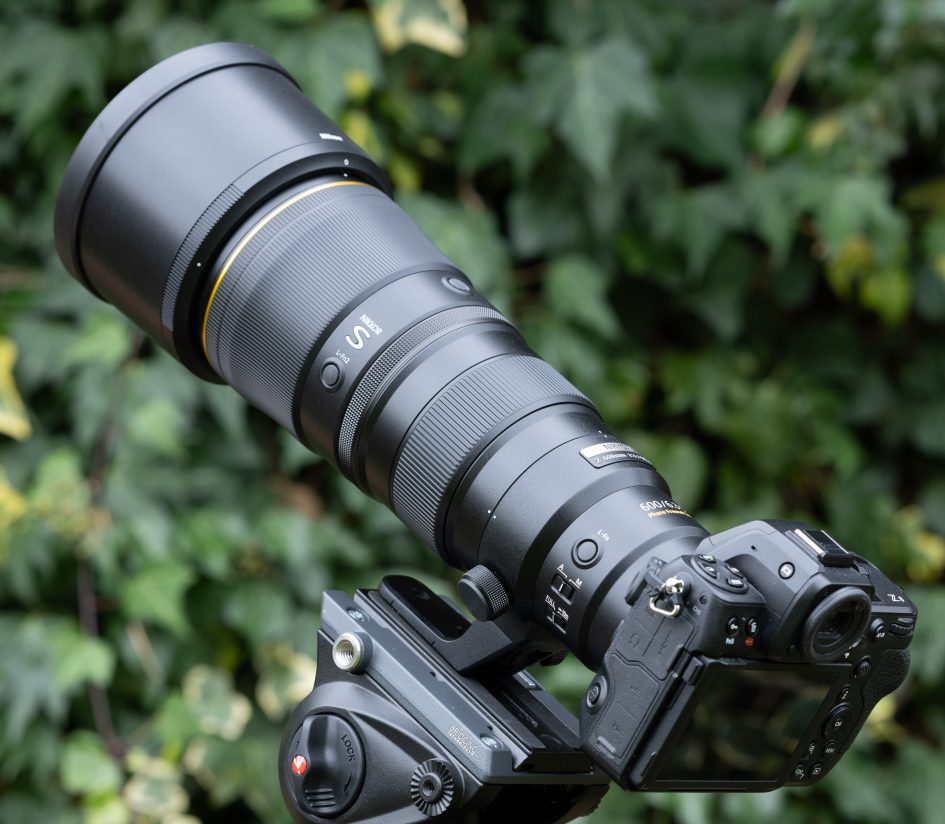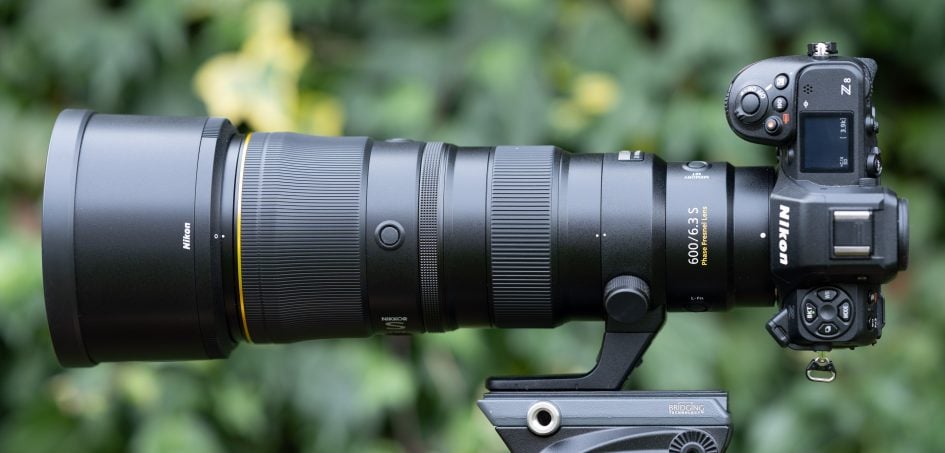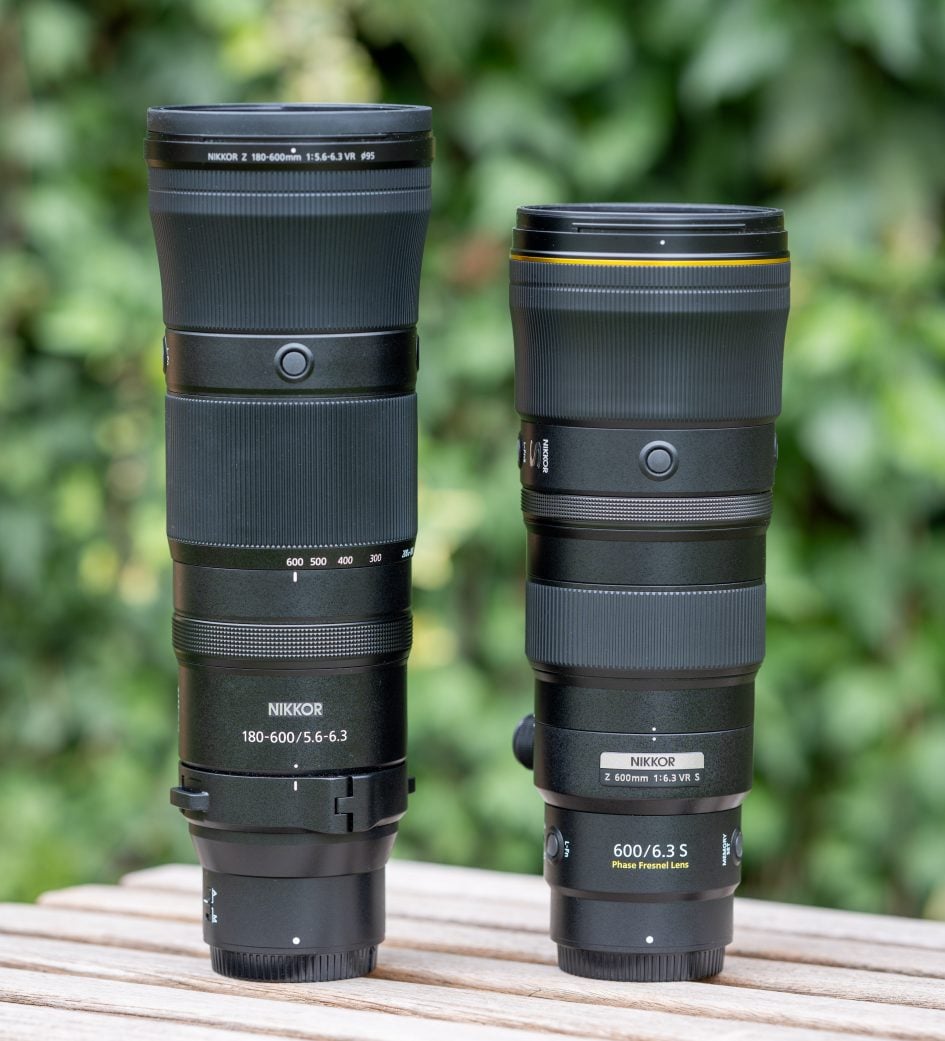Nikon Z 600mm f6.3 VR S review
-
-
Written by Thomas
Intro
The Z 600mm f6.3 VR S is Nikon’s third long telephoto prime lens for Z-mount specifically designed for compact build and light weight – the others being the Z 400mm f4.5 VR S and the Z 800mm f6.3 VR S. Using a Phase-Fresnel element the lens is only 43mm longer and 310g heavier than the diminutive Z 400mm f4.5 VR S. The Z 600mm f6.3 VR S is corrected for full-frame sensors and is compatible for use with Nikon’s Z-mount teleconverters TC-1.4x and TC-2.0x. This allows it to be converted into a 840mm f9 or even 1200mm f13 lens. It has optical image stabilization, a focus limiter, removable tripod foot, programmable L-Fn and L-Fn2 function buttons, an extra memory-set button to save focus distances, and the usual control ring.
The Nikon Z 600mm f6.3 VR S is made in China and costs 5799 EUR / 4797 USD / 4999 GBP which is roughly one third of Nikon’s Z 600mm f4 TC VR S but almost three times as expensive as the Z 180-600mm f5.6-6.3 VR. If you’re interested in the other Z-Nikkors reaching 600mm focal length head over to my Nikon Z 600mm f4 TC VR S review or Nikon Z 180-600mm f5.6-6.3 VR review.
Facts and features
Let’s compare the Nikon Z 600mm f6.3 VR S to Nikon’s Z 600mm f4 TC VR S (“Z 600 TC” for short) and Z 180-600mm f5.6-6.3 VR (“Z 180-600”). I’ve also added some information on Nikon’s Z 400mm f4.5 VR S (“Z 400”) and Z 800mm f6.3 VR S (“Z 800”) just to give you an idea how the new lens compares to Nikon’s other small and light telephoto prime lenses. As usual I’ve rated the features with a [+] (or [++]), when it’s better than average or even state of the art, a [0] if it’s standard or just average, and [-] if there’s a disadvantage.
Size (diameter x length): 107 x 278mm (4.2 x 10.9in.), the lens hood adds 77mm (130mm diameter). The Z 600 TC is 165 x 437mm + 125mm lens hood, the Z 180-600 is 110 x 316mm + 80mm lens hood, the Z 400 is 104 x 235mm + 77mm lens hood, the Z 800 is 140 x 385mm + 126mm lens hood. So the new lens is 21cm shorter than the Z 600 TC and 16cm shorter than the Z 800 (lens hood mounted). [+]
Weight: 1390g (3.1 lb.) plus 83g tripod foot plus 131g for the plastic lens hood adding up to a total weight of 1.60kg. The Z 600 TC is 3.51kg, the Z 180-600 is 2.26kg, the Z 400 is 1.37kg, the Z 800 is 2.62kg. This makes the Z 600mm f6.3 VR S as light as the Z 400 + TC-1.4x. And saves 0.66kg over the Z 180-600 and 1.9kg over the Z 600 TC. [+]
Optics: 21 elements in 14 groups including 3 special dispersion elements and one Phase-Fresnel element. The lens has Nikon’s ARNEO-coating to reduce flare, glare and ghosting (but not the newest “meso amorphous” coating) plus fluorine-coating on the front element to repel water, dust, and dirt and make cleaning easier. The Z 600 TC has 19 elements in 16 groups (+ 7/4 in the internal TC), the Z 180-600 zoom lens has 25 elements in 17 groups, The Z 400 is a 19/13 design without Phase-Fresnel element, the Z 800 is 22/14 including one Phase-Fresnel element. [+]
Minimum object distance is 3.9m (13ft.) with a very long working distance of around 3.6m which made me step back time and again. The Z 180-600 has a much more accommodating MOD of 2.4m (at 600mm focal length; 1.3m at 180mm). The Z 600mm f6.3 VR S has a maximum magnification of 1:6.1 which is not much. A magnification of 1:10 is achieved at around 6.2m object distance. The Z 600 TC achieves a maximum magnification of 1:4.7 when the built-in TC is switched on, the Z 180-600 goes down to 1:3.9 while both the Z 400 and Z 800 achieve around 1:5.8. [0]
Image stabilization: All lenses in this comparison offer optical stabilization (VR) which works in conjunction with the body-based stabilization on Nikon’s full-frame Z cameras to achieve a claimed 5.5 stops of stabilization over 5 axes plus an additional 0.5 stop on camera bodies which support “Synchro-VR” (like Nikon Z6II, Z7II, Z8 and Z9). [+]
Filter-thread: 95mm. That’s larger than most of us have filters for and may mean that you need to get new filters for the lens. But that’s par for the course as both the Z 400, and Z 180-600 also use 95mm filters. The Z 600 TC and Z 800 have a slot for 46mm filters. [0]
Autofocus: All lenses in this comparison offer autofocus with built-in focus drive. Manual-focus override is by simply turning the dedicated focus ring in the middle of the lens (on the Z 180-600 the multi-function ring has to be used). The focus ring has the usual variable gearing which allows for very precise manual focus when turned slowly. You can reverse the focus ring direction and switch to linear response with different settings for focus throw. [+]
Additional functions: There are 4 function buttons at the front (L-Fn2) and an additional L-Fn button behind the focus ring on the lens which can be assigned different functions like AE/AF lock. There’s also a memory set button to save focus positions on the right side close to the camera. All lenses in this comparison also sport a focus-limiter which in case of the Z 600mm f6.3 VR S prevents the lens to search focus closer than 10m (33ft.). [+]
Aperture ring: All lenses in this comparison have the usual slim multi-function control ring which can be assigned to operate the aperture (which is the default), exposure compensation, or ISO sensitivity – or simply switched off. It is located in front of the focus ring – except for the Z 180-600 where the ring is located behind the zoom ring and can also be configured for manual focus. [+]
Lens profile: All Z-Nikkors in this comparison come with a lens profile which can be controlled from the camera. Vignette control offers the usual options of High, Normal, Low and Off. Diffraction compensation and Auto distortion control can be activated or deactivated. [+]
All lenses in this comparison cover full frame/FX or smaller sensors. [+]
Price: 5799 EUR (incl. 19% VAT)/ 4797 USD / 4999 GBP. The Nikon Z 600mm f4 TC VR S currently sells for 17250 EUR / 15500 USD / 15500 GBP, the Z 180-600mm f5.6-6.3 VR S is at 1999 EUR / 1697 USD / 1799 GBP, the Z 400mm f4.5 VR S at 3100 EUR / 3000 USD / 2740 GBP, the Z 800mm f6.3 VR S at 6700 EUR / 6500 USD / 6300 GBP. [0]
Use with teleconverters: All lenses in this comparison can also be used with Nikon’s teleconverters for Z-mount: The Z TC-1.4x for 565 EUR (incl. 19% VAT) / 547 USD / 579 GBP and Z TC-2.0x for 620 EUR / 597 USD / 629 GBP. The Z 600 TC has a 1.4x teleconverter already built in which can simply be activated with a switch. [+]
The Z 600mm f6.3 VR S comes with the usual flimsy pouch with no strings to pull it close. The lens hood is included and locks in place to avoid accidentally falling off plus it is reversible for transport and has a rubberized front-end. The Z 600mm f6.3 VR S has a detachable tripod foot which is identical to the foot of three other lenses: Z 70-200mm f2.8 VR S, Z 100-400mm f4.5-5.6 VR S, Z 400mm f4.5 VR S. Nikon missed out (again) to add an Arca-Swiss compatible groove to the foot, but at least you can swap a replacement foot between these four lenses. The non-detachable tripod ring turns smoothly but has no click-stops at 90 degrees. Under the rubber cap of its screw is a security slot for attaching an anti-theft cable. [0]
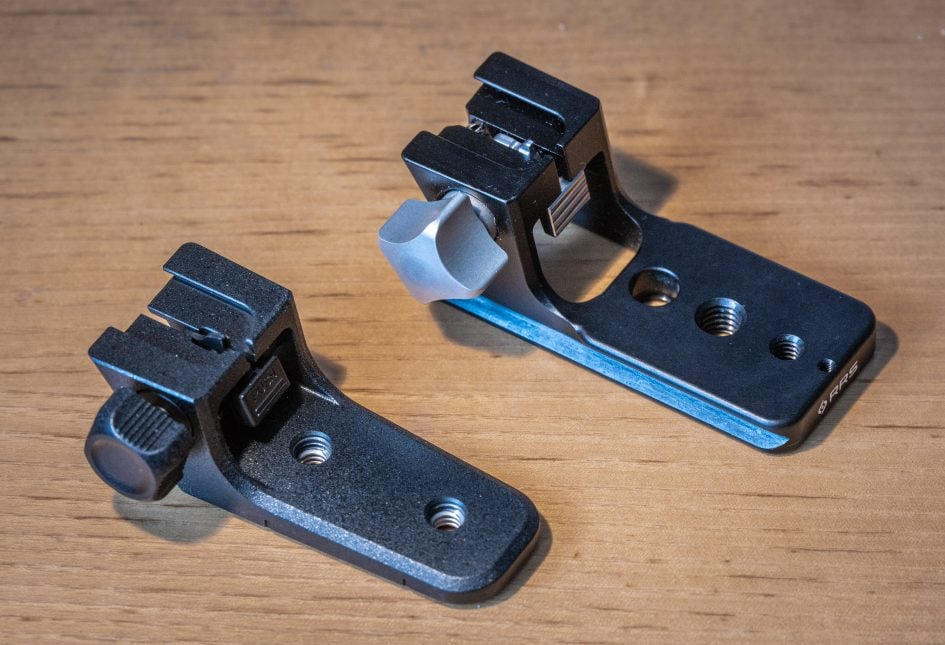
Above: Nikon’s detachable tripod foot (left), Arca-Swiss compatible replacement foot from Really Right Stuff LCF-21 (right)
Sealing: yes. All lenses in this comparison have a rubber grommet at the lens-mount plus further special weather-sealing throughout the construction. [+]
At a score of 0[-]/4[0]/11[+] the Nikon Z 600mm f6.3 VR S turns out to be well featured: For a 600mm lens it’s amazingly light – and small. It can be used with teleconverters to extend its reach and improve the somewhat disappointing maximum magnification of 1:6.6 up to 1:3.3. With very good image quality and stabilization this lens should make for a fine companion for those who like hiking and capturing nature’s and wildlife’s beauty without weighing themselves down. Just keep in mind that at 5799 EUR / 4797 USD / 4999 GBP it’s not exactly cheap.
Above: Nikon Z 180-600mm f5.6-6.3 VR (left), Nikon Z 600mm f6.3 VR S (right)
Focus
Focus accuracy and repeatability is critical to consistently produce sharp shots. Repeatability (the accuracy of focus on the same subject after repeated focus-acquisition) of the Nikon Z 600mm f6.3 VR S is very good (measured 98.8% in Reikan FoCal) with only one slight outlier over a series of 40 shots on the well-lit and contrasty focus test target. And there is almost no focus variation whether the lens focuses from a closer distance or from infinity. On a Nikon Z8 the lens focuses in around 0.5 sec from infinity to 6.2m (1:10 magnification) which is on a par with the Z 180-600mm f5.6-6.3 VR and a tad faster than the Z 600mm f4 TC VR S on a Z9. Hunting wasn’t an issue.
The focus ring is 29mm wide, has a rubberized surface, and moves smoothly. It’s located over the tripod foot. So when using the lens hand-held detach the food or turn it out of the way if you want to use the focus ring.
AF-operation of the lens emits a faint hum in photo-mode or if you record video with the built-in microphone.
As you pull focus, you’ll notice quite some focus breathing: the image became 15% more magnified when I adjusted focus from infinity to 6.2m. This is quite visible when shooting videos and much stronger than on the Z 180-600mm f5.6-6.3 VR (4%).
Image stabilization
To test the effectiveness of the image stabilization with the Nikon Z 600mm f4 TC VR S on a Nikon Z9 camera body, I did a series of 140 test-shots hand-held at 600mm focal length with shutter speeds from 1/640 of a second down to 1/20 sec. I used the shots at 1/640 sec with VR=off as reference of how good my handholding was at the time of the test and Reikan FoCal did the chore of evaluating the sharpness of all shots.
Here’s the results: With VR=on the combined stabilization from lens and camera produced no outliers in the 80 shots from 1/640 down to 1/80 sec (3 stops) with average sharpness clearly better than at 1/640 sec with VR=off. At 1/40 sec (4 stops) there were 3 outliers in 20 shots. And at 1/20 sec (5 stops) results became as erratic as at 1/640 sec with VR=off. This is an impressive performance of the combined optical and sensor-based image stabilization although not quite as good as Nikon’s claim of 6 stops.
Next check out my quality results!
Check prices on the Nikon Z 600mm f6.3 VR S at B&H, Adorama, WEX UK or Calumet.de. Alternatively get yourself a copy of my In Camera book, an official Cameralabs T-shirt or mug, or treat me to a coffee! Thanks!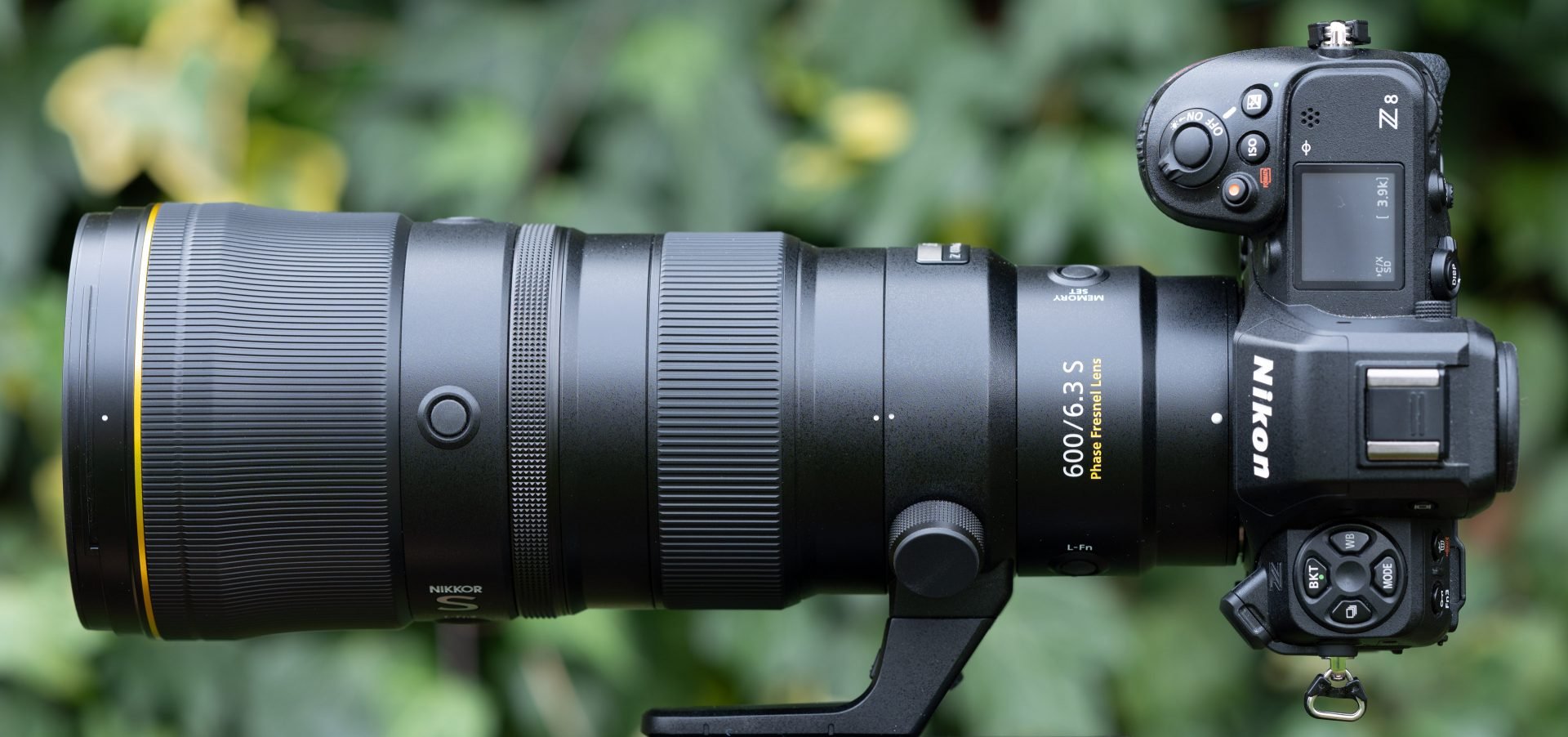
 Nikon’s Z 600mm f6.3 VR S is a very good addition to their long telephoto line-up fitting right between the Z 400mm f4.5 VR S and the Z 800mm f6.3 VR S: It has an unrivalled low weight, compact size, and very good optical performance with virtually no field-curvature or colour aberrations. It can confidently be used wide open or in combination with Nikon’s Z TC-1.4x teleconverter but using the TC-2.0x taxes the abilities of the lens a bit. Its Bokeh is very nice and the optical image stabilization of 5 stops proves really helpful with the challenges of hand-holding an 600mm lens. All this makes the Z 600mm f6.3 VR S Highly Recommended.
Nikon’s Z 600mm f6.3 VR S is a very good addition to their long telephoto line-up fitting right between the Z 400mm f4.5 VR S and the Z 800mm f6.3 VR S: It has an unrivalled low weight, compact size, and very good optical performance with virtually no field-curvature or colour aberrations. It can confidently be used wide open or in combination with Nikon’s Z TC-1.4x teleconverter but using the TC-2.0x taxes the abilities of the lens a bit. Its Bokeh is very nice and the optical image stabilization of 5 stops proves really helpful with the challenges of hand-holding an 600mm lens. All this makes the Z 600mm f6.3 VR S Highly Recommended.